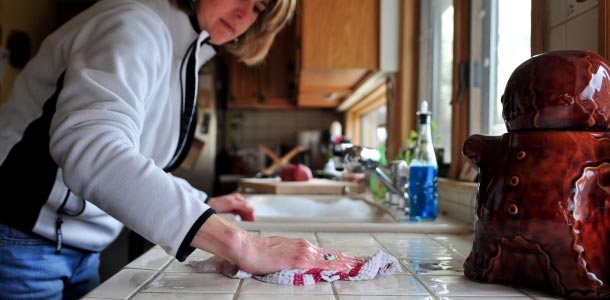 Food safety begins long before you begin actual food preparation. Recently I’ve been teaching a series of classes on food preservation and one of the very first topics discussed is cleaning and sanitizing your kitchen counters, cutting boards and other utensils.
Food safety begins long before you begin actual food preparation. Recently I’ve been teaching a series of classes on food preservation and one of the very first topics discussed is cleaning and sanitizing your kitchen counters, cutting boards and other utensils.
While there has been and continues to be debate of whether a wooden or plastic cutting board is the best choice, there are some basic guidelines which must always be followed to ensure food preparation is done safely.
- Make sure counter tops, cutting boards and other utensils are washed in hot, soapy water after each use. Thoroughly rinse them and then either allow them to air dry or pat them dry with fresh paper towels. Cutting boards which are glass, non-porous plastic or solid wood may be washed in a dishwasher. It is not recommended putting laminated cutting boards in the dishwasher as they may crack or peel.
- Inspect the cutting board. If the cutting board is extremely worn or has hard-to-clean grooves, it’s time to replace it. Deep grooves make it difficult to thoroughly clean and increases the risk of contamination.
- Sanitize your cutting board. One misconception is that if you can’t smell the bleach in the water, you probably aren’t using enough. Actually it only takes one Tablespoon of bleach per gallon of water to create a sanitizing solution. Just think how much money you’ll save by using less bleach.
During one of my classes, a participant stated she couldn’t use bleach because she was allergic to it and wanted to know what could be used instead to sanitize cutting boards and countertops. Other solutions include using either vinegar OR hydrogen peroxide but NEVER mixing them together. Be sure and test the hydrogen peroxide solution in an unseen place to make sure it doesn’t discolor or fade the surface.
- Heat either ½ cup of hydrogen peroxide (3%) OR ½ cup white distilled vinegar (5%) in a sauce pan to 150⁰F or 66⁰C. Be sure and handle heated liquids carefully as they will be warm but not hot. Using a funnel pour the warm solution into a spray bottle. Immediately spray the cutting board, counter tops or other kitchen surfaces. Let solution remain on the surface for 1 minute and then wipe with a clean paper towel.
- It is possible to use the same concentration of either the hydrogen peroxide (3%) OR white distilled vinegar (5%) solution without heating the solution. All products would need to be at room temperature and must remain on the surfaces for 10 minutes and then wipe the surface with a clean paper towel.
When doing food preparation, be sure and use separate cutting boards for meats, vegetables and fruits. This will keep from cross-contaminating the food products and reduces the risk of spreading bacteria and other pathogens.
These simple steps will help make sure your food preparation practices are off to a safe start.
References:
Buffer, J., Medeiros, L, Schroeder, M., Kendall, P., LeJeune, J. and Sofos, J. 2010. Cleaning & Sanitizing. Funded by USDA, National Research Initiative under Agreement #2004-51110-02160 and 2005-51110-03278. www.ext.colostate.edu
Haraminac, E. Food safety: Safely prepping produce on your cutting board. 2013. Michigan State University Extension. http://msue.anr.msu.edu
Written By: Treva Williams, Extension Educator, Family & Consumer Sciences, Ohio State University Extension, Scioto County.
Reviewed By: Linnette Goard, Field Specialist, Food Safety, Selection, and Management, Family and Consumer Sciences, Ohio State University Extension.

I use all 100% FDA approved food safe materials on my cutting boards however when not cleaned properly any cutting board can grow bacteria. you should always try to avoid meat on a wood cutting board.
Robert Wendt
https://www.etsy.com/shop/woodbob?ref=hdr_shop_menu